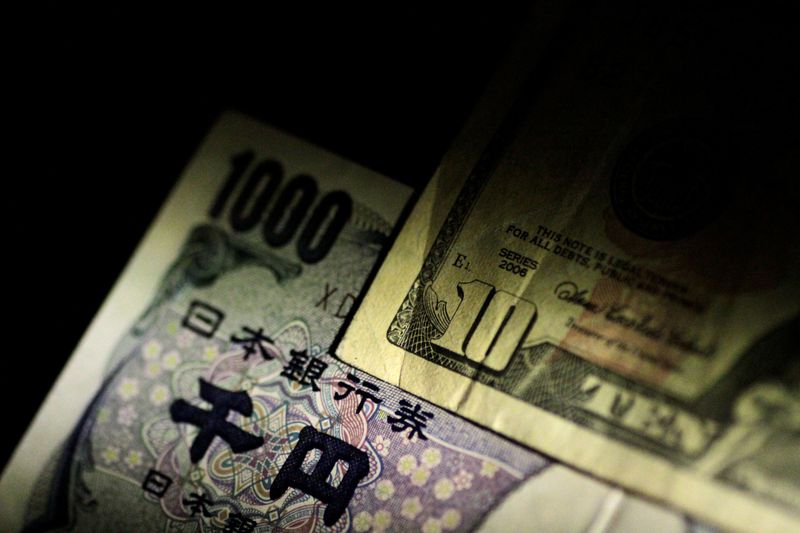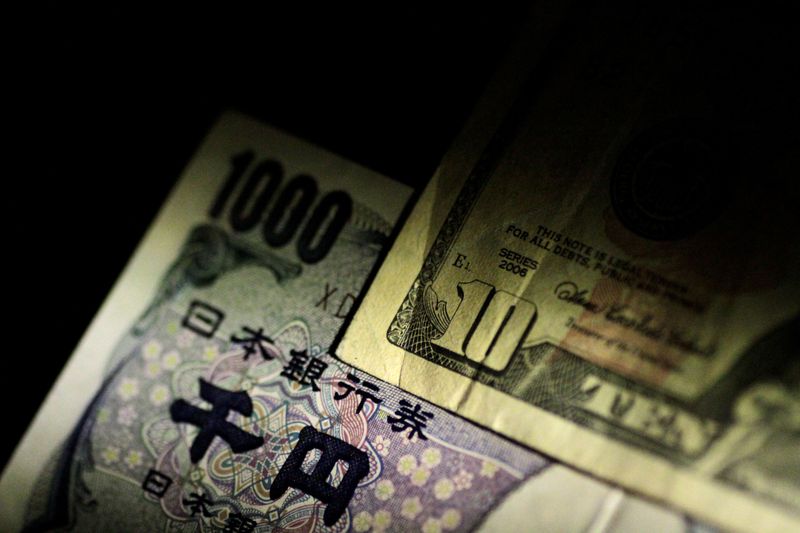Forex
Dollar weakens after yen steadies amid intervention jitters

By Alden Bentley, Samuel Indyk and Ankur Banerjee
NEW YORK/LONDON (Reuters) -The dollar eased from a near eight-week high on Monday, with traders back on alert for intervention to support the yen after the Japanese currency flirted with the 160 per dollar level that had earlier drawn verbal warnings from Japanese authorities.
Dollar/yen topped at 159.94 in early trade, its highest since April 29, when the yen touched a 34-year low of 160.245, leading to Japanese authorities spending roughly 9.8 trillion yen to support the currency.
It briefly tumbled in the European morning to 158.75 per dollar, and was last 0.28% weaker at 159.35.
“Certainly didn’t look like intervention … nonetheless, it does speak to how jittery the market likely is about the prospect for intervention,” said Michael Brown, senior research strategist at Pepperstone.
“I think so long as any further weakness is not especially rapid or disorderly in nature, the MoF (Ministry of Finance) are unlikely to step in just yet.”
Earlier, Japan’s top currency diplomat Masato Kanda said authorities will take appropriate steps if there is excessive foreign exchange movement, and that the addition of Japan to the U.S. Treasury’s monitoring list would not restrict their actions.
The yen has come under renewed pressure after the Bank of Japan’s (BOJ) decision this month to postpone reducing bond-buying stimulus until its July meeting. It is down 1.5% in June.
A summary of opinions at the BOJ’s June policy meeting on Monday showed some policymakers called for raising interest rates in a timely fashion as they saw a risk of inflation overshooting expectations.
The yen, which is highly sensitive to U.S. Treasury yields, is down more than 10% against the dollar so far this year, weighed down by the wide difference between interest rates in Japan and the United States.
“We are all trying to figure out if there is a specific level that the MOF may have in mind in terms of defense or whether or not it comes down to general market conditions,” said Brian Daingerfield, FX strategist at Natwest Markets in Stamford, Connecticut.
INFLATION TEST AHEAD
The spotlight this week will be on Friday’s release of the U.S. personal consumption expenditures (PCE) price index, which the Federal Reserve relies on to gauge progress in getting inflation down to its 2% target.
A number showing price pressures easing is likely to bolster bets on a rate cut as early as September, which futures currently price as a 70% prospect.
The , which measures the greenback against a basket of currencies including the yen and the euro, fell 0.41% to 105.45, edging back from a nearly eight-week high of 105.91 it touched last week.
Another focus through the week will be politics. The first U.S. presidential debate between President Joe Biden and his predecessor Donald Trump is on Thursday after U.S. markets close.
“Certainly there’s quite a bit of interest in whether or not the dollar is specifically mentioned,” said Daingerfield. “We know former President Trump has at times criticized the value of the dollar as being too strong.”
The first round of voting in the French election is on Sunday.
“You’re going to see a lot of defensive positioning going into the first round of the French election and U.S. presidential debate,” said Simon Harvey, head of FX analysis at Monex.
The euro, which has been under pressure since French President Emmanuel Macron called a snap election earlier this month, was up 0.44% at $1.0738 but was still down about 1% in June so far.
France’s far right National Rally (RN) party and its allies were seen leading the first round of the country’s elections with 35.5% of the expected vote, an opinion poll published on Sunday showed.
RN lawmaker Jean-Philippe Tanguy, who is widely seen as the most likely candidate to head the finance ministry if the party wins and forms a government, told Reuters an RN government would stick to the European Union’s fiscal rules.
Sterling strengthened 0.28% at $1.268. The Australian dollar strengthened 0.18% versus the greenback to $0.6651 and the strengthened 0.16%.

Meanwhile, spot yuan was trading at 7.2585 per dollar, close to its lowest in seven months, weighed by broad strength in the dollar and worries about weakness in the world’s second-largest economy. [CNY/]
In cryptocurrencies, bitcoin fell to its lowest since May 10 and was down 4.52% at $61,267.00. declined 5.98% at $3310.26.

 Forex3 years ago
Forex3 years agoForex Today: the dollar is gaining strength amid gloomy sentiment at the start of the Fed’s week

 Forex3 years ago
Forex3 years agoUnbiased review of Pocket Option broker

 Forex3 years ago
Forex3 years agoDollar to pound sterling exchange rate today: Pound plummeted to its lowest since 1985

 Forex3 years ago
Forex3 years agoHow is the Australian dollar doing today?

 Cryptocurrency3 years ago
Cryptocurrency3 years agoWhat happened in the crypto market – current events today

 World3 years ago
World3 years agoWhy are modern video games an art form?

 Commodities3 years ago
Commodities3 years agoCopper continues to fall in price on expectations of lower demand in China

 Economy3 years ago
Economy3 years agoCrude oil tankers double in price due to EU anti-Russian sanctions


























